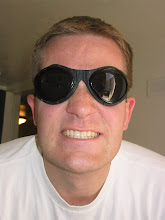Tuesday, October 28, 2008
CMMS?
Today I have been attempting to use some organizational software. I have had so much difficulty with it that I probably shouldn't mention it by name. I can see that there is some possibility that it could be of use to someone. I don't see how it could be useful to me without a lot more training. Hopefully there is some software out there for people that is more intuitive.
Tuesday, October 7, 2008
What Does a Network Look Like?
I have recently learned a bit about networks. They can be large or small. The largest network would be the entire web. The smallest would be two devices connected to each other. Somewhere in the middle are the LAN, MAN, and WAN's. (local, metropolitan, and wide area networks) These connections between devices can be hard wired or wireless through bluetooth technology or infrared transfer. These networks come in four basic configurations and a few hybrid varieties. I will describe each of them as simply as I know how.
The Mesh type is the most widely used. The biggest example of this is the World Wide Web. The major advantage to this type is the fact that individual or even partial failure does not bring down the entire network. The disadvantage to this is all the extra cabling required.
The Bus type is very simple, but can be most easily be compared to an electrical series. Like the old strands of Christmas lights, when one goes out-they all go out.

The Ring type is where all the connections link to a circular path. A "token"(like a miniature mail carrier) runs from connection to connection looking for data to deliver in an endless circle. The major advantage here is the ease of connecting lots of devices.
The Star type configuration is just like it sounds. Each device is connected to a central hub. This one is illustrated her on the right.
The Mesh type is the most widely used. The biggest example of this is the World Wide Web. The major advantage to this type is the fact that individual or even partial failure does not bring down the entire network. The disadvantage to this is all the extra cabling required.
The Bus type is very simple, but can be most easily be compared to an electrical series. Like the old strands of Christmas lights, when one goes out-they all go out.

The Ring type is where all the connections link to a circular path. A "token"(like a miniature mail carrier) runs from connection to connection looking for data to deliver in an endless circle. The major advantage here is the ease of connecting lots of devices.
The Star type configuration is just like it sounds. Each device is connected to a central hub. This one is illustrated her on the right.
Tuesday, September 30, 2008
Interesting Development

Ok, so pictures these days are not really developed, but I did have some fun with pictures today. I was given some software that hides files inside of another file. It's called stenography. Its pretty cool stuff. I took a picture of my old motorcycle and hid a word document in it. I was able to send it to a friend and have them open it with the same software and reveal the hidden doc. The down side of this software was that it trashed the resolution on my picture when I had to convert it to bitmap. But I did see a demonstration where there was no change in a high resolution photo. It just didn't work for me. Oh well, it is still cool technology.
Monday, September 22, 2008
Exploring a New Vektr
 Today I looked into some workflow software called Vektr. It seemed to have everything needed for communicating the ongoing workload of a large company. I don't have any experience with other brands, but I thought the user interface could have been simplified slightly. For example, every time I clicked on the details of an item, it would bring up a new page showing a lot of the same information from the previous one. I think there was a way to edit that. I saw
Today I looked into some workflow software called Vektr. It seemed to have everything needed for communicating the ongoing workload of a large company. I don't have any experience with other brands, but I thought the user interface could have been simplified slightly. For example, every time I clicked on the details of an item, it would bring up a new page showing a lot of the same information from the previous one. I think there was a way to edit that. I saw  options that limited or expanded the types of information shown. I can definitely see the benefits of using a system like this for most larger companies. Besides the time savings, it communicates simply and clearly to each of the involved employees, provided they have convenient (possibly mobile) access to it. I would recommend this product to most mid to large companies.
options that limited or expanded the types of information shown. I can definitely see the benefits of using a system like this for most larger companies. Besides the time savings, it communicates simply and clearly to each of the involved employees, provided they have convenient (possibly mobile) access to it. I would recommend this product to most mid to large companies.
Wednesday, September 10, 2008
In the Beginning

This is where it starts. This weeks assignment is to start a blog. In the next few weeks I will be reporting on technologies relating to the field of facility, property and operations management. The areas of possible study include different aspects of building automation. Windows/lighting, HVAC, or security systems will most likely be the topics for future research.
Labels:
building automation,
facility,
management,
operations,
property,
technology
Subscribe to:
Posts (Atom)
